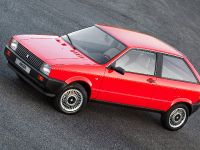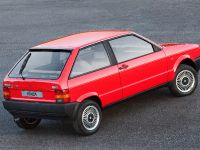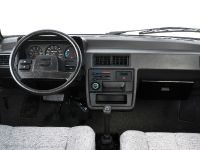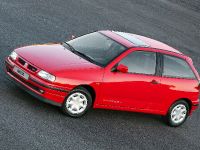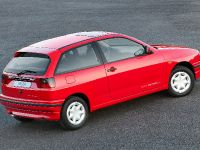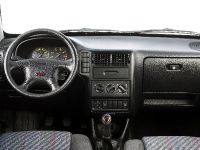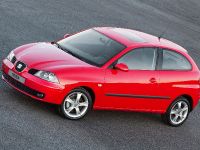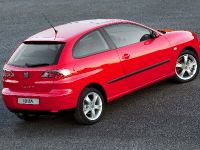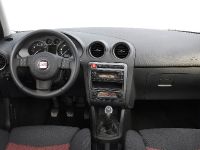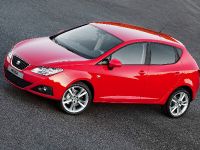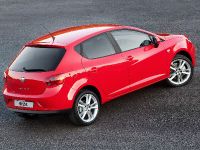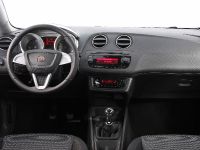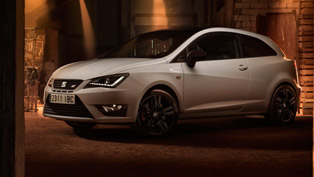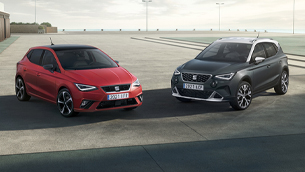Seat’s Sporty Supermini Celebrates 25 Years
It was back at the 1984 Paris Motor Show that the world caught its first glimpse of a Spanish supermini that would shake up the small car class for good, bringing much-needed style and excitement to the sector and establishing SEAT as a key component of the Volkswagen Group.
The public unveiling 25 years ago of the Ibiza Mk I signalled the start of a motoring success story that has taken the car to worldwide sales of more than four million and, in the process, the title of SEAT's best-selling model of the modern era.
The Ibiza is a landmark, too, as it was the first product to be wholly developed by SEAT as a fully independent company.
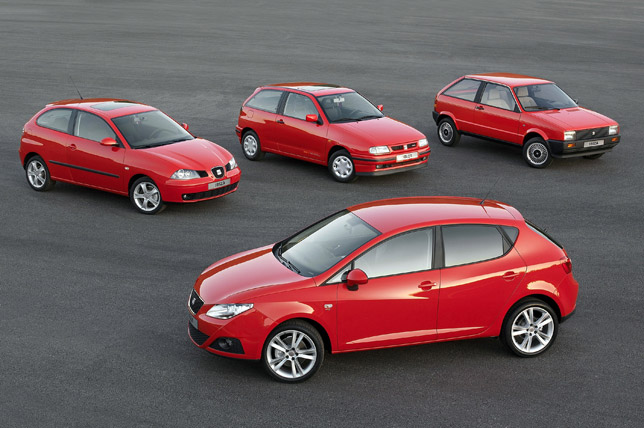
SEAT Ibiza Mk I
Throughout its history, the Ibiza has always displayed a sporty, youthful spirit and has stood out for its engaging performance and exceptional value for money.
The first generation car clearly threw down the gauntlet to the established players in the class by combining the spaciousness and interior comfort of higher segment models in a more compact body (3.6 metres long).
To create the first Ibiza SEAT went straight to some of the most well-known names in the industry, collaborating with Italian designer Giorgio Giugiaro's Italdesign, as well as Karmann for industrialisation and Porsche for the powertrain technology (called ‘System Porsche' and proudly displayed on the engine).
With a choice of petrol engines ranging from 44 PS to a spirited 100 PS, as well as an efficient 55 PS diesel, the Ibiza quickly became a powerful magnet for both domestic and foreign buyers.
After seven successful years on the market, in 1991 the model underwent a complete transformation - entitled New Style - which saw revisions to both the front end and the interior trim. At the same time the Sport Line version made its debut in Spain equipped with the latest System Porsche engine evolution: a 1.7-litre powerplant good for 110 PS.
The following year, the SEAT Ibiza became the official car of the Barcelona '92 Olympic Games. From its launch in 1984 until 1993, sales of the first generation Ibiza totalled a remarkable 1,342,001 units.
SEAT Ibiza Mk II
Following such a successful debut was never going to be easy but, in 1993, the Spanish brand announced the second generation of the Ibiza, a car that would quickly follow in the successful tyre tracks of its predecessor.
Noteworthy for a number of reasons, perhaps the most important fact about the second generation car was that it became the first SEAT to be manufactured in the new Martorell factory, 30 kms from SEAT's original Barcelona base.
Unveiled at the 1993 Barcelona Motor Show, the car was developed within the Volkswagen Group and featured a total of six engine choices (petrol, diesel and turbo-diesel) with three- and five-door body styles on offer.
The Ibiza took a giant leap forward in terms of manufacturing quality, and became the first model in its segment to be equipped with a 90 PS TDI engine. Three years later, in 1996, it repeated this feat with the debut of a potent 110 PS TDI engine which became the most powerful diesel engine in its segment.
Also in 1996, SEAT debuted what was quickly to become another landmark model with the unveiling of its first, spectacular, Ibiza Cupra - equipped with a fire-breathing 150 PS 2.0-litre engine. This much-anticipated launch was also used by SEAT to celebrate its brilliant victory in the 2.0-litre category of the FIA World Rally Championship with the SEAT Ibiza Kit Car, a title it would go on to win again in 1997 and 1998.
At the 1999 Barcelona Motor Show the Ibiza featured revamped styling with revised looks inside and out. Among the changes were larger light units and a reworked grille to match the brand's new image. The interior featured a prominent new multi-function screen that displayed information relating to the trip computer, climate control and radio.
A year later in May 2000, and coinciding with SEAT's 50th anniversary, the company presented the new SEAT Ibiza Cupra equipped with a turbocharged 156 PS 1.8-litre petrol powerplant. This car marked another important ‘first' for SEAT by becoming the first car in its class to feature ESP (electronic stability programme).
Meanwhile, the experience gained by SEAT Sport through competing for six successful years in World Rally Championship events delivered a direct benefit for SEAT buyers with the launch of the range-topping, ultra-sporty SEAT Ibiza Cupra R, the first mass-produced model developed by the company's motorsport division. This exclusive car was equipped with a class-leading 180 PS 1.8-litre 20V turbo engine.
Unsurprisingly perhaps, sales of the Ibiza Mk II outstripped those of the previous generation with a total of 1,522,607 units sold between 1993 and 2002.
SEAT Ibiza Mk III
The third generation of the Ibiza saw the light in 2001 and signalled another significant leap in manufacturing quality, engineering and dynamic performance.
Designed by no less a motoring legend than Walter de Silva, the Ibiza for the Noughties featured an undeniably more attractive silhouette that underlined its increased agility.
More than that, though, the 2001 Ibiza was the brand's first model to introduce the Agile Chassis concept across its entire range. Developed by the Martorell Design Centre it also raised the power bar, with diesel engines of up to 130 PS.
In 2004 the Ibiza celebrated its 20th anniversary in a big way, with more than 3.3 million units manufactured and with the introduction of two new sporty versions that would become the Spanish brand's enthusiast cars of choice. FR was offered with 130 PS 1.9 TDI diesel and 150 PS 1.8-litre petrol turbo engines while Cupra, whose 160 PS 1.9 TDI was, again, the most powerful diesel engine in its segment, also boasted the option of a 180 PS 1.8-litre 20V petrol engine.
In February 2006 the SEAT Ibiza debuted a new, more modern, and yet more sporty image. The main improvements included new interior trim and new bumpers on a range that, in its home market, offered 18 versions and combined five trim levels with no fewer than 11 engine choices.
Equipped with an 80 PS 1.4-litre TDI engine and DPF (diesel particulate filter) the first generation Ibiza Ecomotive was presented at the end of 2007, instantly becoming the greenest car in its segment with CO2 emissions of only 99 g/km.
Sales of the third generation Ibiza reached a total of 1,084,989 between 2002 and 2007 making it the best-selling supermini in Spain since its launch, while the model is still available in the SEAT sales network in its home country.
SEAT Ibiza Mk IV
A year ago, SEAT began the roll-out of its fourth generation Ibiza with two key words that perfectly sum up the new car - ‘beauty' and ‘technology'.
Quality is, of course, another key feature of the new Ibiza going hand-in-hand with its exterior and interior style.
The new model debuts designer Luc Donckerwolke's ‘Arrow Design' concept at the front, lending the new Ibiza a sporty, yet more distinctive look thanks to the use of sharp geometric lines as well as the evolution of the brand's classic Dynamic Line sweeping across the sides.
Equipment on today's Ibiza also puts SEAT's ‘baby' in pole position in its class, with the likes of head-chest airbags, ESP (electronic stability programme), Hill Hold Control and low tyre pressure warning all available.
Euro NCAP crash tests have validated the excellent work carried out by the Martorell Technical Centre, resulting in five stars for passenger protection, four stars for child safety and three stars for pedestrian protection.
The new Ibiza also features excellent dynamics thanks to the use of a brand new Volkswagen Group platform. A key ‘first' for today's Ibiza is the availability of a state-of-the-art seven-speed DSG gearbox mated to the 105 PS 1.6-litre petrol engine for the first time in its segment. Among several significant advantages of this twin clutch system over old-fashioned automatic gearboxes, DSG delivers greater driving comfort without affecting the traditional sporty nature that's integral to all SEAT models.
Engine options in today's Ibiza SC and Ibiza 5dr include a suite of smooth and willing petrol powerplants: 70 PS 1.2; 85 PS 1.4; and 105 PS 1.6 while diesel options (available in some markets) include an 80 PS 1.4 TDI and forthcoming 105 PS 1.6-litre four cylinder TDI, which brings with it cutting edge common rail fuelling.
They all feature exceptionally low CO2 emissions with the new, second generation, Ecomotive versions laying claim to be the joint lowest emitting five-seater in their class with an official output of just 98 g/km.
The new Ibiza range is growing all the time, of course, with the imminent arrival of new versions such as the spectacular Ibiza Cupra, FR and head-turning Ibiza Cupra Bocanegra, the last two of which having made their world debuts just days ago at the Barcelona Motor Show.
As ever these new cars have powerful, efficient engines, excellent performance, generous equipment and cutting edge technology such as XDS and Bi-xenon headlights with AFS.
Boasting attractive designs, engaging dynamics, exciting performance and exceptional economy, today's Ibiza looks better placed than ever to build on the firm foundations of the last 25 years and underpin SEAT's ambitious target of 800,000 global sales annually by 2018.
